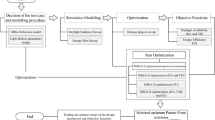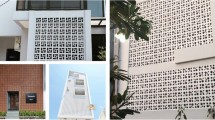Abstract
Buildings around the world have been confronting too much energy consumption. On that account, architectural aspects have an important role to minimize this energy consumption. Overheating has become a current topic especially in summer with hot climates, since the use of large glazed facades have become prevalent. Thus, shading devices should be considered in the early stage of the design process to overcome this task. Since the design of a new shading device is a complicated architectural design problem, the presented problem can be tackled with real-parameter multi-objective optimization. The well-known and fast Non-Dominated Sorting Genetic Algorithm II so called NSGA-II was used to solve this complex design problem and identify alternative solutions to decision makers. An implementation of the method is presented, focusing on louvers design integrated to an office building in a hot-dry climate region.
Access this chapter
Tax calculation will be finalised at checkout
Purchases are for personal use only
Similar content being viewed by others
References
Yang, I.-H., Nam, E.-J.: Economic analysis of the daylight-linked lighting control system in office buildings. Sol. Energy 84, 1513–1525 (2010)
Jenkins, D., Newborough, M.: An approach for estimating the carbon emissions associated with office lighting with a daylight contribution. Appl. Energy 84, 608–622 (2007)
Li, D.H.W.: A review of daylight illuminance determinations and energy implications. Appl. Energy 87, 2109–2118 (2010)
Freewan, A.A.Y.: Impact of external shading devices on thermal and daylighting performance of offices in hot climate regions. Sol. Energy 102, 14–30 (2014)
Bellia, L., Marino, C., Minichiello, F., Pedace, A.: An overview on solar shading systems for buildings. Energy Proc. 62, 309–317 (2014)
Khoroshiltseva, M., Slanzi, D., Poli, I.: A pareto-based multi-objective optimization algorithm to design energy-efficient shading devices. Appl. Energy 184, 1400–1410 (2016)
Stevanovic, S.: Optimization of passive solar design strategies: a review. Renew. Sustain. Energy Rev. 25, 177–196 (2013)
Zemella, G., De March, D., Borrotti, M., Poli, I.: Optimised design of energy efficient building facades via evolutionary neural networks. Energy Build. 43(12), 3297–3302 (2011)
Manzan, M.: Genetic optimization of external fixed shading devices. Energy Build. 72, 431–440 (2014)
Blanco, J.M., Buruaga, A., Rojí, E., Cuadrado, J., Pelaz, B.: Energy assessment and optimization of perforated metal sheet double skin facades through design builder; a case study in Spain. Energy Build. 111, 326–336 (2016)
Nguyen, A.T., Reiter, S., Rigo, P.: A review on simulation-based optimization methods applied to building performance analysis. Appl. Energy 113, 1043–1058 (2014)
Evins, R.: A review of computational optimisation methods applied to sustainable building design. Renew. Sustain. Energy Rev. 22, 230–245 (2013)
Nabil, A., Mardaljevic, J.: Useful daylight illuminance: a new paradigm to access daylight in buildings. Light. Res. Technol. 37(1), 41–57 (2005)
Deb, K., Pratap, A., Agarwal, S., Meyarivan, T.: A fast and elitist multi objective genetic algorithm: NSGA-II. IEEE Trans. Evol. Comput. 6(2), 182–197 (2002)
Chatzikonstantinou, I., Sariyildiz, S., Bittermann, M.S.: Conceptual airport terminal design using evolutionary computation. In: 2015 IEEE Congress on Evolutionary Computation (CEC), pp. 2245–2252 (2015)
Grasshopper, Algorithmic Modeling for Rhino. http://www.grasshopper3d.com/
DIVA for Rhino. http://www.solemma.net/DIVA-for-Rhino/DIVA-for-Rhino.html
Ward, G.J., Lighting Group, Building Technologies Program, Lawrence Berkeley Laboratory: The RADIANCE lighting simulation and rendering system. In: Proceedings of the 21st Annual Conference on Computer Graphics and Interactive Techniques, pp. 459–472. ACM, New York (1994). https://doi.org/10.1145/192161.192286. ISBN 0-89791-667-0
Crawley, D.B., Lawrie, K., Pedersen, C.O., Winkelmann, F.C.: EnergyPlus: energy simulation program. ASHRAE J. 42(4), 49–56 (2000)
Reinhart, C.F., Weismann, D.A.: The daylit area – correlating architectural student assessments with current and emerging daylight availability metrics. Build. Environ. 50, 155–164 (2012)
Acknowledgement
The work and the contribution were supported by the SPEV project “Smart Solutions in Ubiquitous Computing Environments”, University of Hradec Kralove, Faculty of Informatics and Management, Czech Republic (under ID: UHK-FIM-SPEV-2018).
Author information
Authors and Affiliations
Corresponding author
Editor information
Editors and Affiliations
Rights and permissions
Copyright information
© 2018 Springer Nature Switzerland AG
About this paper
Cite this paper
Kirimtat, A., Krejcar, O. (2018). Energy-Daylight Optimization of Louvers Design in Buildings. In: Nguyen, N., Pimenidis, E., Khan, Z., Trawiński, B. (eds) Computational Collective Intelligence. ICCCI 2018. Lecture Notes in Computer Science(), vol 11056. Springer, Cham. https://doi.org/10.1007/978-3-319-98446-9_42
Download citation
DOI: https://doi.org/10.1007/978-3-319-98446-9_42
Published:
Publisher Name: Springer, Cham
Print ISBN: 978-3-319-98445-2
Online ISBN: 978-3-319-98446-9
eBook Packages: Computer ScienceComputer Science (R0)




